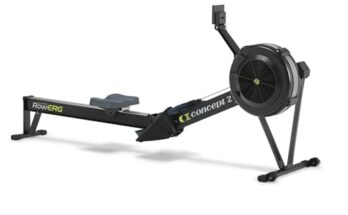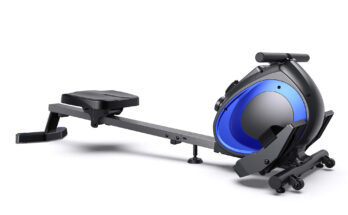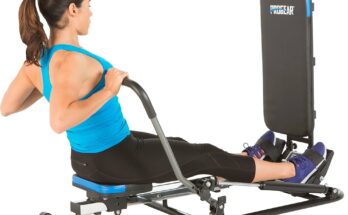Have you ever wondered which workout gives you the biggest health boost: rowing or running? If you’re trying to choose between these popular exercises, you’re not alone.
You want to invest your time in an activity that delivers results and keeps you feeling great, right? Imagine finding a workout that not only helps you stay fit but also minimizes injury risk and maximizes enjoyment. Rowing and running each have their champions, but which one truly reigns supreme in the health department?
By the end of this article, you’ll know exactly which exercise aligns best with your fitness goals and lifestyle. Get ready to uncover the surprising benefits and potential downsides of these two powerhouse workouts.
Physical Benefits Of Rowing
Are you searching for a workout that offers amazing physical benefits? Rowing might be your answer. While running is often hailed as the go-to fitness activity, rowing provides unique advantages that could be more beneficial for your body. Let’s dive into the physical benefits of rowing and discover why it might be the perfect exercise for you.
Full-body Workout
Rowing engages almost every muscle group in your body. Unlike running, which primarily targets your legs, rowing requires you to use your arms, back, and core. This means you’re not just working out your lower body, but you’re also strengthening your upper body. Imagine the feeling of every muscle working in harmony as you glide across the water or power through your rowing machine at home.
Muscle Building And Toning
Rowing is excellent for muscle building and toning. As you pull and push, you’re constantly challenging your muscles, which helps them grow stronger and more defined. You might notice your arms becoming more toned and your back gaining strength. And don’t forget your legs—they get a great workout too! You’ll appreciate the balanced muscle development compared to activities that focus on just one area.
Calorie Burn And Weight Loss
Rowing is a calorie-burning powerhouse. You could burn up to 600 calories in an hour of intense rowing, depending on your weight and intensity level. That’s a significant amount, especially if you’re trying to shed some pounds. Plus, because you’re engaging your entire body, you might find your metabolism gets a boost, helping with weight loss even after your workout is done.
So, why not add rowing to your fitness routine? It offers a full-body workout, builds and tones muscles, and helps with weight loss. Could rowing be the change your body needs? Give it a try and feel the difference.

Physical Benefits Of Running
Running is a popular exercise with numerous physical benefits. It strengthens the heart, builds strong bones, and boosts endurance. Each stride brings unique advantages for overall health and fitness.
Cardiovascular Health
Running enhances heart health. It increases heart rate and improves circulation. This helps in reducing the risk of heart disease. Regular running strengthens the heart muscles. It also lowers blood pressure and cholesterol. A strong cardiovascular system means better oxygen flow to muscles. This boosts energy and efficiency in daily activities.
Bone Strength
Running promotes bone strength. The impact on bones during running stimulates growth. This is crucial for maintaining bone density. Strong bones reduce the risk of osteoporosis and fractures. Running is a weight-bearing exercise. It encourages bones to adapt and get stronger. This is especially important as we age.
Endurance And Stamina
Running improves endurance and stamina. Consistent running trains the body to use oxygen efficiently. This enhances physical performance over time. Improved stamina means you can perform tasks longer without fatigue. Running also boosts mental endurance. It builds discipline and resilience. This mental strength helps in various life challenges.
Impact On Joints
Rowing offers a gentler impact on joints compared to running. This makes it a better choice for those with joint concerns. The smooth, low-impact nature of rowing reduces strain while still providing a full-body workout.
When considering the impact on your joints, it’s crucial to weigh the benefits and risks associated with different forms of exercise. Rowing and running are both popular choices, but they affect your body in distinct ways. Understanding these differences can help you make an informed decision about which exercise suits your needs and lifestyle best.Low-impact Rowing
Rowing is a low-impact activity, making it a gentle option for your joints. Your feet remain in contact with the footplates, avoiding the repetitive pounding associated with running. The fluid motion mimics natural movement, which can reduce stress on your knees and hips. A friend of mine, who switched to rowing after years of running, found relief from chronic knee pain. Have you considered how a low-impact exercise might benefit your joints?High-impact Running
Running, while a fantastic cardiovascular workout, is high-impact. Each stride generates a force that travels up your legs and into your joints. For some, this can lead to wear and tear, particularly on the knees and hips. I remember training for my first marathon and noticing the toll it took on my knees. Do you notice any discomfort after a long run?Injury Risks
Rowing reduces the risk of certain injuries common in high-impact sports. The controlled environment of a rowing machine minimizes unexpected movements that can lead to injury. However, improper form can still cause issues, so learning correct technique is vital. On the other hand, running carries a higher risk of injuries like shin splints and stress fractures. Have you ever had to stop running due to an injury? By understanding the impact of these activities on your joints, you can choose the one that aligns with your health goals. Whether you opt for the low-impact benefits of rowing or the high-energy burn of running, prioritize your joint health to keep enjoying your favorite workouts.Mental Health Benefits
Rowing and running both offer significant mental health benefits. Engaging in physical activity can help improve your mental well-being. Rowing offers unique advantages due to its rhythmic and full-body nature.
As you glide through the water, your mind finds peace. This tranquility can greatly benefit your mental state.
Stress Reduction
Rowing helps lower stress levels. The repetitive motion creates a calming effect. This can be similar to meditation. As you row, your body releases endorphins. These hormones help reduce stress naturally. Each stroke allows your mind to focus and relax.
Mood Improvement
Rowing can lift your mood significantly. Exercise releases dopamine and serotonin. These chemicals enhance feelings of happiness. The rhythmic nature of rowing adds to the joy. Consistent rowing can lead to improved emotional well-being.
Cognitive Boost
Rowing engages both your body and mind. The coordination required boosts cognitive function. It helps improve your focus and concentration. Regular rowing sessions can enhance mental clarity. This mental workout can sharpen your mind over time.
Accessibility And Convenience
Exploring whether rowing is healthier than running highlights its accessibility and convenience. Rowing provides a full-body workout. It’s gentle on the joints and can be done indoors. Running, on the other hand, is easily accessible outdoors and requires minimal equipment.
Both exercises offer unique health benefits.
When it comes to choosing a workout, accessibility and convenience often top the list of considerations. Rowing and running are popular choices, each with its own set of advantages. How do they compare in terms of accessibility and convenience? Let’s break it down by examining the equipment and space needed, weather and environment factors, and the cost considerations associated with each activity.Equipment And Space
Rowing requires access to a rowing machine or a body of water if you prefer the great outdoors. Many gyms offer rowing machines, making them accessible if you have a gym membership. However, if you decide to row at home, space can be a concern as rowing machines are sizable. Running, on the other hand, needs minimal equipment. A good pair of running shoes and comfortable attire are usually sufficient. You can run almost anywhere, from city streets to country trails, making it a versatile option.Weather And Environment
Rowing indoors on a machine allows you to exercise regardless of the weather. This is a big plus during rainy seasons or extreme temperatures. Outdoor rowing, however, is heavily reliant on calm weather conditions and access to suitable water bodies. Running gives you flexibility with the environment. You can choose between treadmill running indoors or hitting the pavement outside. While weather can impact outdoor runs, many runners find ways to adapt by dressing appropriately or choosing alternative routes.Cost Considerations
Rowing machines can be a significant investment if purchased for home use, often ranging from several hundred to a few thousand dollars. Gym memberships provide a more cost-effective way to access rowing equipment without the upfront cost. Running is generally low-cost, especially if you stick to public roads or trails. The primary expense is typically a pair of quality running shoes, which need replacing every 300-500 miles to avoid injury. So, how do you weigh these factors? Do you prefer the structured environment of rowing, or the simplicity and freedom of running? Your choice may depend on what fits best with your lifestyle and budget.
Which Is Right For You?
Deciding whether rowing or running suits you best depends on several factors. Each exercise offers unique benefits and challenges. By assessing your goals and lifestyle, you can make an informed decision.
Personal Fitness Goals
Consider what you want to achieve with your workouts. Rowing is excellent for building upper body strength. It engages the arms, shoulders, and back. Running is ideal for improving cardiovascular health and endurance. It primarily targets the lower body. Both exercises burn calories, helping with weight loss.
Lifestyle And Preferences
Your daily routine can affect your choice. Rowing requires specific equipment, often needing access to a machine or water. Running is more flexible. You can run almost anywhere, anytime. Think about the time you can dedicate to exercise. Rowing may require more setup, while running is straightforward.
Health Conditions
Assessing any health conditions is crucial. Rowing is low-impact, reducing stress on joints. It’s suitable for those with knee or ankle issues. Running is high-impact and may aggravate joint problems. Consult with a healthcare professional if unsure. They can guide you based on your health needs.

Frequently Asked Questions
Is Rowing Better For Joints Than Running?
Yes, rowing is generally easier on the joints compared to running. It offers a low-impact workout, which reduces stress on knees and ankles. This makes it an ideal exercise for those with joint concerns or injuries. However, it’s essential to maintain proper form to avoid strain.
Does Rowing Burn More Calories Than Running?
Rowing can burn a significant number of calories, similar to running. The exact calorie burn depends on intensity and duration. Generally, running might burn more calories per minute. However, rowing engages more muscle groups, offering a full-body workout, which can enhance calorie burn over time.
Can Rowing Improve Cardiovascular Health More Effectively?
Rowing is excellent for cardiovascular health, similar to running. It increases heart rate and improves endurance. Both exercises enhance heart health, but rowing also strengthens upper body muscles. The choice depends on personal preference and fitness goals, as both are effective for cardiovascular fitness.
Is Rowing More Suitable For Weight Loss?
Rowing is effective for weight loss when combined with a balanced diet. It provides a full-body workout, boosting metabolism and burning calories. Consistency and intensity play a crucial role in weight loss. Rowing can be as effective as running for weight management, depending on individual effort and routine.
Conclusion
Choosing between rowing and running depends on personal goals. Both offer unique benefits. Rowing enhances upper body strength and is gentle on joints. Running boosts cardiovascular health and burns calories quickly. Consider your fitness level and any health issues. Rowing suits those with joint concerns.
Running may be ideal for weight loss. Try both to find what fits best. Variety in workouts keeps you engaged. Listen to your body and enjoy the journey. Your fitness path is personal. Make it enjoyable and sustainable.



